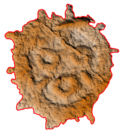Medvezhi Shchoki
Bas-relief in the cave Medvezhi Shchoki.
Drawing from a photo by Fedorov. Okladnikov, 1971
The exact location of the cave has not been recorded. The cliff of the coast is the inner side of the caldera wall of the Baranovski volcano, which is rapidly disintegrating under the influence of lateral erosion of the river. According to the description of A. Z. Fedorov, the cave was observed in soft reddish tuffs, which were artisanally developed in the 1920s by the peasants of the Krasny Yar village as a source of raw material for the colorful pigments making. He observed traces of the tuffs extraction in the cave itself. The description suggests an artificial origin of the cave itself, formed as a result of the mining of soft rock, especially since “next to the main cave there were two more small caves formed by tuff seekers.” The place of these developments is clearly visible on modern satellite images. The rocks that make up the caldera of the Baranovski volcano, are volcanic-sedimentary tuff breccia containing volcanic bombs. It is these formations that could be taken by a researcher who has no geological training, for “high-relief images of a human head almost in full size”.
According to A. P. Okladnikov, the images were destroyed along with the cave as a result of the extraction of volcanic tuff. This information is not entirely accurate, since the quarry for industrial production of pumice is located 900 m from the river cliff. The cave, apparently, was destroyed as a result of the continued artisanal extraction of pigments by the peasants and the impact of landslide processes caused by lateral erosion of the river.
The site of Medvezhi Shchoki («Bear’s Cheeks») was described in 1928 by A. Z. Fedorov in the area of the Baranovsky railway passing loop (Nadezhdinsky district of Primorsky Krai). According to A. Z. Fedorov’s description, on a cliff of the Suifun (Razdolnaya) River in a small cave, he observed three high-relief images of a human head, according to A. P. Okladnikov, similar to the bas-relief masks of Sikachi-Alyan. The discoverer of the images, A. Z. Fedorov, doubted their ancient origin and assumed that “the sculptor could be a botanist who excursed with an ordinary botanical digger and used it as a cutter”.
View of the cave location from the bridge
over Suifun (Razdolnaya) River.
Photo by N. Vorobyov, 2018


